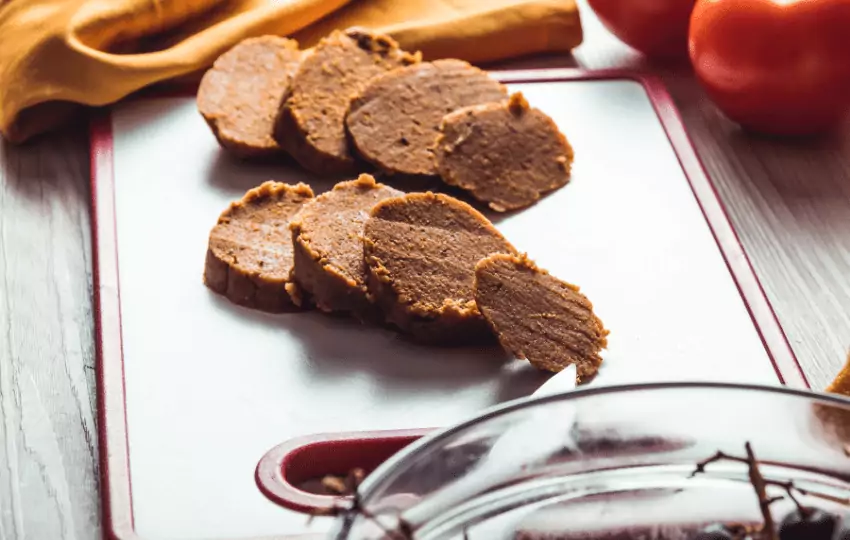A vegan diet sometimes becomes challenging because the perfect healthy ingredients can not find everywhere, like Vital Wheat Gluten- A high protein meat alternative.
Whether you’re a mom or a chef, discovering vital wheat gluten substitutes can be tricky for new ingredients to experiment with.
But don’t worry, I’m here to help. In this post, I’ll explore some of the best substitutes for vital wheat gluten so that you can uncover the ideal one for your needs, including some replacements that will work well in your baking recipes too.
So let’s have a look…
What is Vital Wheat Gluten?
Wheat gluten is a type of protein found in wheat. It is made up of two proteins, glutenin and gliadin. Wheat gluten is used to make the dough more elastic and increase the bread’s volume and texture.
Wheat gluten is also known as vital wheat gluten. It is also known as seitan, miàn jīn (Chinese), milgogi (Korean), wheat meat, gluten meat, vital wheat gluten, or simply gluten. This is because it is an essential ingredient in the baking process. If you do not include wheat gluten in your bread dough, the bread will be dense and will not rise properly.
Gluten is a composite carbohydrate featuring elastic proteins and insoluble gluten. The main ingredient in this dish is wheat flour doughs which have been washed until all starch granules were removed, leaving behind only sticky glue-like strands of protein that give it its signature chewy quality when cooked before being eaten!
Can I leave out vital wheat gluten?
When considering whether or not to incorporate vital wheat gluten in a recipe, a few factors are to consider.
First, it is crucial to understand what it is and what it does. Vital wheat gluten is a protein made from the gluten in wheat flour.
It works as a thickener and adds structure to baked goods. Without it, many baked goods would be dense and heavy.
If you’re not gluten intolerant or allergic, there is no harm in leaving it out of a recipe.
However, suppose you are trying to create a gluten-free version of a recipe. In that case, it is important to replace the vital wheat gluten with a gluten-free thickener.
Several gluten-free thickeners are available, such as xanthan gum or guar gum.
Seitan or Vital Wheat Gluten Substitutes
When baking, many ingredients can be substituted for one another to achieve a similar outcome. For example, you can use either all-purpose flour or bread flour as the base when baking bread.
1. PROTEIN POWDER- Best Vital Wheat Gluten Substitute
There are a few factors why you would want to substitute protein powder for wheat gluten.
- First, gluten sensitivity
- Second, if you’re trying to cut back on carbs, protein powder is an excellent practice to add some additional protein to your diet without all the extra carbs.
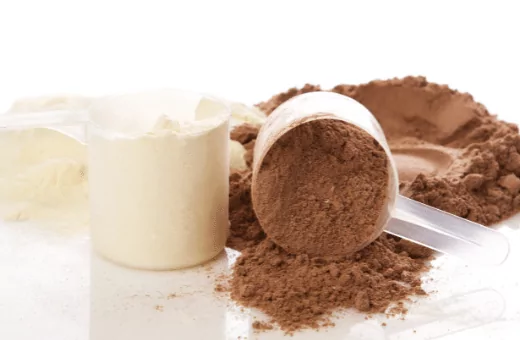
There are a few different types of protein powder on the market, so you can choose the one that best suits your needs.
If you’re looking for a high-quality, all-natural protein powder, I recommend using whey protein isolate. It’s the purest form of whey protein available. It has a high protein content and low carbohydrate and fat content.
If you’re looking for a vegan-friendly protein powder, I recommend using pea protein powder. It’s a plant-based protein that is high in protein and low in carbs and fat.
When replacing wheat gluten with protein powder, you’ll need to use a little more than the amount of wheat gluten called for in the recipe.
For example, if a recipe calls for 1/2 cup wheat gluten, you’ll need to use 3/4 cup protein powder. Be sure to blend the protein powder with some water or other liquid before adding it to the recipe; otherwise, it will be too thick.
2. GUAR GUM- Decent Gluten-Free Seitan Alternative in Baking
When the gluten-free dough is made, oftentimes guar gum is substituted for vital wheat gluten. It has a slightly sweet taste.
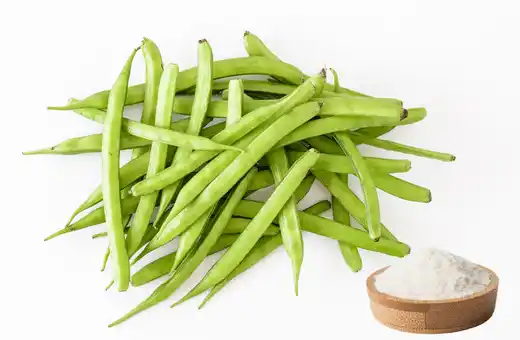
Guar gum is a plant-based thickener that helps to give dough structure and elasticity. Guar gum is an adequate substitute for vital wheat gluten and helps to produce a dough that is both elastic and has a good structure.
There are a few different types of guar gum that can be used in gluten-free baking.
Guar gum is also available in a processed form, which is made from guar beans that have been milled and then chemically treated. This form of guar gum is a white, powdery substance that is a little bit more processed than the natural form.
Both forms of guar gum work well in gluten-free baking, but the processed form has a longer shelf life.
When using guar gum in gluten-free baking, it is essential to use the correct amount.
If too much guar gum is used, the dough will be heavy and dense. If too little guar gum is used, the dough will not have enough structure and will be challenging to work with.
A general rule of thumb is to utilize 1/4 teaspoon of guar gum for every cup of flour in the recipe. This will aid in ensuring that the dough has the proper structure and elasticity.
3. XANTHAN GUM- Good Alternative to Vital Wheat Gluten
Like vital wheat gluten, xanthan gum is a natural ingredient that helps to improve the texture and elasticity of the dough.
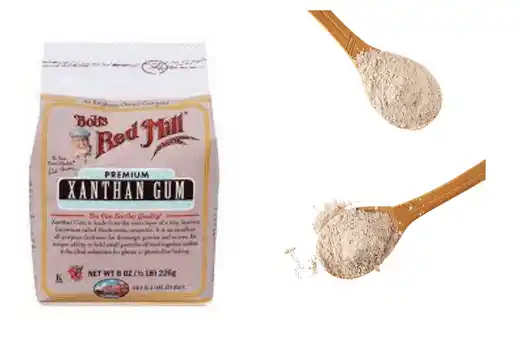
So, you can easily substitute in recipes that call for vital wheat gluten. When using xanthan gum as a substitution for vital wheat gluten, for every 1/4 cup of vital wheat gluten called for, use 1 teaspoon of xanthan gum in a recipe.
If you are unsure about how much xanthan gum to use, start with a smaller amount and add more as needed.
Adding too much xanthan gum can result in a sticky or gummy texture, so it is important to use caution when adding this ingredient. In most cases, a little goes a long way.
4. Use PRE-GEL STARTS to Replace Seitan
Wheat gluten is a beneficial source of protein for people who want to maintain a vegetarian or vegan diet. Still, it can be difficult for those with gluten sensitivities to find foods that don’t contain protein.
A recent study has shown that pre-gel, a plant-based product made from cornstarch, can successfully replace wheat gluten in many food products.
Pre-gel is an excellent option for those looking for a vegan or gluten-free protein source. It is made from cornstarch, so it is naturally gluten-free. It has a similar texture to wheat gluten, making it a good substitute in many recipes.
Pre-gel is also a good source of fiber and other nutrients, making it a healthy addition to any diet.
5. HIGH-GLUTEN FLOUR- Best Substitute for Vital Wheat Gluten
One of these is using high-gluten flour to substitute vital wheat gluten. This will help add some of the lost structure when gluten is removed from a recipe.
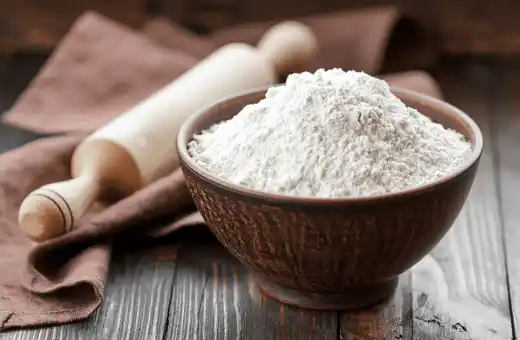
One cup of high-gluten flour can be substituted for one tablespoon of vital wheat gluten. If a recipe calls for more than one tablespoon of gluten, increase the amount of high-gluten flour accordingly.
Keep in mind that using high-gluten flour will add starchiness to the final product, so adjust the other ingredients in the recipe.
6. READY-MADE SEITAN – A Good Replacement for Vital Wheat Gluten
Some people may be looking for a ready-made seitan product to substitute vital wheat gluten.
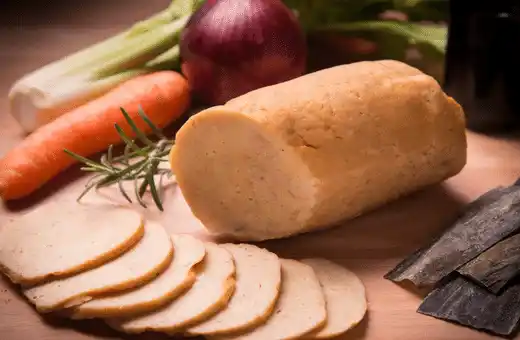
A few brands are available on the market, such as Upton’s Naturals and Tofurky, which both make seitan that is pre-seasoned and ready to use in recipes.
If you’re searching for a gluten-free option, a few brands make seitan from soybeans, such as Wheat-Free Seitan by Edward and Sons.
7. WHEY PROTEIN
A current study posted in the Journal of Agricultural and Food Chemistry found that whey protein can be used to replace vital wheat gluten (VWG) in bread dough.
VWG is a major component of bread dough, responsible for its structure and elasticity. When replaced with whey protein, bread dough becomes more elastic and less dense.
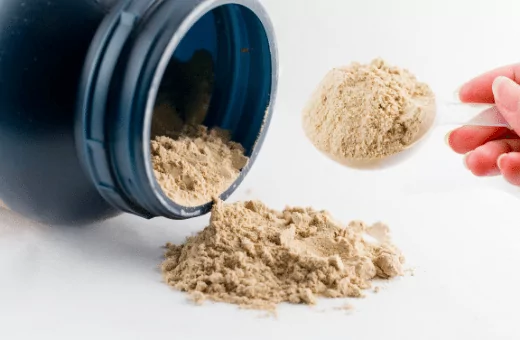
Whey protein is a favored choice for people looking for a vegetarian or vegan source of protein. Whey protein is derived from milk or plant-based milk, so it is not suitable for people with a dairy allergy or intolerance.
Whey protein is a complete source of protein, meaning that it contains all the essential amino acids needed to build muscle.
8. EGG- Similar Protein like Vital Wheat Gluten
One common substitution for vital wheat gluten is an egg.
When mixed with water, eggs form a sticky and elastic dough that can be used to replace gluten in many recipes.
The end product is slightly chewier when made with eggs, but the substitution works well overall.
You can also utilize a commercial egg replacer like Ener-G Egg Replacer. This product is made from potato starch, tapioca flour, and leavening agents and is gluten-free.
9. MEAT ANALOUGE- Best Substitute for Seitan meat analogue.
When making a wheat-based vegan meat analogue, vital wheat gluten is a critical ingredient.

Vital wheat gluten is the main protein in wheat and gives bread its spongy texture. It also has a meat-like texture and can be used as a vegetarian meat replacement in dishes such as tacos, pizza, and burgers.
However, vital wheat gluten can be expensive and difficult to find. It may not be available in your local grocery store in some cases.
You can substitute a meat analogue made from beans or lentils if this case. These substitutes will not have the same texture as vital wheat gluten. However, they will still provide some of the nutritional benefits of wheat.
10. Try BREAD FLOUR Instead of Seitan
You can use bread flour to replace vital wheat gluten in a recipe.
Bread flour is high in gluten, which will help to add structure to your baked goods. You may require to add more liquid to your recipe if you are using bread flour, as it has a higher starch content than vital wheat gluten.
If you’re glancing for a gluten-free option, you can try using a combination of rice flour and potato starch. This combination will help add some structure to your baked goods without sacrificing flavor.
11. Vital wheat gluten substitute FLAXSEED
One way to make wheat-free or gluten-free bread is to use flaxseed as a binding agent in place of vital wheat gluten.
To do this, mix 2 cups of warm water with 1/4 cup of ground flaxseed. Allow the mixture to settle for about 10 minutes so that the flaxseed can absorb the water and form a thick gel.
Then, combine this mixture with the remaining components in your bread recipe.
12. Vital wheat gluten substitute PSYLLIUM HUSK
Psyllium husk is a high-fiber food and contains about 7 grams of dietary fiber per tablespoon. It is an excellent substitution for vital wheat gluten in bread recipes.
Psyllium husk creates a more dense and chewy texture in bread, similar to whole wheat flour. When adding psyllium husk to bread recipes, increase the liquid content by about ¼ cup for every cup of psyllium husk used.
Psyllium husk can also be used as a thickener in soups, stews, and sauces. Add about 1 tablespoon of psyllium husk to every cup of liquid that needs thickening. Psyllium husk will thicken as it sits, so it is best to add it to the liquid just before cooking.
Adding psyllium husk to your diet can aid regulate bowel movements and reduce the risk of heart disease and other chronic health conditions.
How to Make Vital Wheat Gluten
13. HOMEMADE VITAL WHEAT GLUTEN
Making your own vital wheat gluten at home is easy and only requires a few simple ingredients.
Ingredients:
- 2 cups of wheat flour
- 1 cup of water
- 1 tsp. salt
- 3 tsp. vegetable oil or olive oil
Instructions:
Start by combining 2 cups of wheat flour, 1 cup of water, and 1 tsp. Salt in a medium bowl. Stir in 3 tsp. Vegetable oil or olive oil until the dough is smooth.
Turn the dough out onto a lightly floured board, and knead for about 10 minutes. Then, spread the dough to a thickness of 1/4 inch and cut it into 2-inch squares.
Put the squares on a baking sheet lined with parchment paper and bake for 20 minutes (175 degrees C) or until golden brown.
Vital wheat gluten can also be stored in the refrigerator or freezer for later use. Simply place the desired amount in an airtight container, and store it in the fridge for up to 2 weeks or in the freezer for up to 3 months.
Vital wheat gluten substitute for seitan
There are a few different vital wheat gluten substitutes for seitan.
Use TVP (textured vegetable protein); some use flour, and some use chickpea flour.
I’ve tried all three, and they’re all effective. Chickpea flour is your best bet if you’re searching for a gluten-free option.
However, if you are not gluten-free, I recommend using flour because it has a more “meaty” texture.
To make seitan using flour:
Mix 1 cup of wheat flour with 2/3 cup of water. Knead the dough for about 5 minutes until it is smooth. Then, cut off a piece of dough and roll it into a ball.
Flatten the dough ball with your hand, and then use a knife to cut it into thin strips. Finally, curl the strips into seitan “ribs.”
To make seitan using TVP:
Mix 1/2 cup of TVP with 1/3 cup of water. Let the TVP soak for about 5 minutes, then knead it into a dough. Again, cut off a piece of dough and roll it into a ball.
Flatten the dough ball with your hand, and then use a knife to cut it into thin strips. Finally, curl the strips into seitan “ribs.”
Check More- Best Substitute for Yeast Nutrients
Vital wheat gluten substitute for bread
Vital Wheat Gluten is Often used to make bread fluffy and chewy. There are a few Alternatives to seitan, which you can use as a substitution.
· You can try using xanthan gum, a thickener that can be used as a gluten replacement. Also, try using a combination of gluten-free flours in your bread recipe.
· Use dry baked wheat gluten to make bread like in Japan.
Wrap Up on Substitutes for Seitan
Using any of these substitutes may work well for you. Individually has its own distinctive flavor and texture, so be sure to test them out in your favorite recipes to see which ones give you the best results. Happy baking!
FAQs Related to Seitan Substitutes
Q1. Is vital wheat gluten bad for you?
The effects of consuming vital wheat gluten may vary from person to person. Some individuals who consume vital wheat gluten may experience adverse side effects such as bloating, constipation, and diarrhea.
However, other people may not experience any negative symptoms at all.
Therefore, it is important to consult with a healthcare professional to see if consuming vital wheat gluten is right for you. And always consume the right amount of food and avoid any excessive intake.
Q2. Is vital wheat gluten the same as gluten flour?
Gluten flour is made from wheat that has been ground into a fine powder. This type of flour is used in baking because it helps to create a chewy texture and binding properties in baked goods.
On the other hand, Vital wheat gluten is a concentrated form of gluten that is made from the gluten proteins in wheat. It is used as a thickening and to give dishes structure.
So, while both gluten flour and vital wheat gluten contain gluten proteins, they are not the same thing.
Vital wheat gluten is more concentrated, so you need less of it to achieve the same results. This is why it is often used in gluten-free baking recipes as a substitute for gluten flour.
Q3. What does vital wheat gluten do to bread?
Wheat gluten, or vital wheat gluten, is a protein contained in wheat flour. It helps to make bread dough elastic and sticky, which allows it to rise and keep its shape, and also gives bread its chewy texture.
Vital wheat gluten is used in small amounts in bread recipes, typically about 2-3 tablespoons per batch. It can be located in the baking aisle of most grocery shops.
Q4. Can I use regular flour instead of vital wheat gluten?
While you could use regular flour in place of vital wheat gluten in many recipes, the results will not be the same.
Vital wheat gluten is a type of concentrated gluten used to add structure and chewiness to baked goods. Your baked items may be dense or gooey if you don’t use it.
If you are looking for a substitute for vital wheat gluten, you could try using a combination of flour and xanthan gum or guar gum. However, it is important to note that the results may not be identical.
Q5. Do Whole Foods have vital wheat gluten?
Whole Foods does carry vital wheat gluten, which can be found in the baking aisle. It is usually used as a substitute for eggs in baking.
The gluten helps bind the ingredients together and gives the baked good structure.
Vital wheat gluten is also a source of protein, making it a popular choice for vegan and vegetarian recipes. It can be used to make everything from bread and cakes to meatless burgers and sausages.

